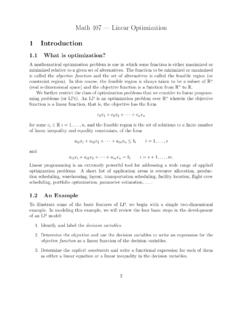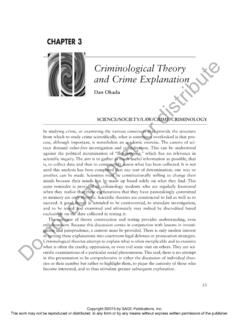Transcription of Computational Geometry - ELTE
1 Computational Geometry Third Edition Mark de Berg Otfried Cheong Marc van Kreveld Mark Overmars Computational Geometry Algorithms and Applications Third Edition 123. Prof. Dr. Mark de Berg Dr. Marc van Kreveld Department of Mathematics Department of Information and Computer Science and Computing Sciences TU Eindhoven Utrecht University Box 513 Box 5600 MB Eindhoven 3508 TB Utrecht The Netherlands The Netherlands Dr. Otfried Cheong, ne Schwarzkopf Prof. Dr. Mark Overmars Department of Computer Science Department of Information KAIST and Computing Sciences Gwahangno 335, Yuseong-gu Utrecht University Daejeon 305-701 Box Korea 3508 TB Utrecht The Netherlands ISBN 978-3-540-77973-5 e-ISBN 978-3-540-77974-2.
2 DOI ACM Computing Classi cation (1998): , Library of Congress Control Number: 2008921564. 2008, 2000, 1997 Springer-Verlag Berlin Heidelberg This work is subject to copyright. All rights are reserved, whether the whole or part of the material is concerned, speci cally the rights of translation, reprinting, reuse of illustrations, recitation, broadcasting, reproduction on micro lm or in any other way, and storage in data banks. Duplication of this publication or parts thereof is permitted only under the provisions of the German Copyright Law of September 9, 1965, in its current version, and permission for use must always be obtained from Springer. Violations are liable for prosecution under the German Copyright Law.
3 The use of general descriptive names, registered names, trademarks, etc. in this publication does not imply, even in the absence of a speci c statement, that such names are exempt from the relevant protective laws and regulations and therefore free for general use. Cover design: K nkelLopka, Heidelberg Printed on acid-free paper 987654321. Preface Computational Geometry emerged from the eld of algorithms design and analysis in the late 1970s. It has grown into a recognized discipline with its own journals, conferences, and a large community of active researchers. The success of the eld as a research discipline can on the one hand be explained from the beauty of the problems studied and the solutions obtained, and, on the other hand, by the many application domains computer graphics, geographic information systems (GIS), robotics, and others in which geometric algorithms play a fundamental role.
4 For many geometric problems the early algorithmic solutions were either slow or dif cult to understand and implement. In recent years a number of new algorithmic techniques have been developed that improved and simpli ed many of the previous approaches. In this textbook we have tried to make these modern algorithmic solutions accessible to a large audience. The book has been written as a textbook for a course in Computational Geometry , but it can also be used for self-study. Structure of the book. Each of the sixteen chapters (except the introductory chapter) starts with a problem arising in one of the application domains. This problem is then transformed into a purely geometric one, which is solved using techniques from Computational Geometry .
5 The geometric problem and the concepts and techniques needed to solve it are the real topic of each chapter. The choice of the applications was guided by the topics in Computational Geometry we wanted to cover; they are not meant to provide a good coverage of the application domains. The purpose of the applications is to motivate the reader;. the goal of the chapters is not to provide ready-to-use solutions for them. Having said this, we believe that knowledge of Computational Geometry is important to solve geometric problems in application areas ef ciently. We hope that our book will not only raise the interest of people from the algorithms community, but also from people in the application areas.
6 For most geometric problems treated we give just one solution, even when a number of different solutions exist. In general we have chosen the solution that is easiest to understand and implement. This is not necessarily the most ef cient solution. We also took care that the book contains a good mixture of techniques like divide-and-conquer, plane sweep, and randomized algorithms. We decided not to treat all sorts of variations to the problems; we felt it is more important to introduce all main topics in Computational Geometry than to give more detailed information about a smaller number of topics. v P REFACE Several chapters contain one or more sections marked with a star.
7 They con- tain improvements of the solution, extensions, or explain the relation between various problems. They are not essential for understanding the remainder of the book. Every chapter concludes with a section that is entitled Notes and Comments. These sections indicate where the results described in the chapter originated, mention other solutions, generalizations, and improvements, and provide refer- ences. They can be skipped, but do contain useful material for those who want to know more about the topic of the chapter. At the end of each chapter a number of exercises is provided. These range from easy tests to check whether the reader understands the material to more elaborate questions that extend the material covered.
8 Dif cult exercises and exercises about starred sections are indicated with a star. A course outline. Even though the chapters in this book are largely indepen- dent, they should preferably not be treated in an arbitrary order. For instance, Chapter 2 introduces plane sweep algorithms, and it is best to read this chapter before any of the other chapters that use this technique. Similarly, Chapter 4. should be read before any other chapter that uses randomized algorithms. For a rst course on Computational Geometry , we advise treating Chapters 1 . 10 in the given order. They cover the concepts and techniques that, according to us, should be present in any course on Computational Geometry .
9 When more material can be covered, a selection can be made from the remaining chapters. Prerequisites. The book can be used as a textbook for a high-level under- graduate course or a low-level graduate course , depending on the rest of the curriculum. Readers are assumed to have a basic knowledge of the design and analysis of algorithms and data structures: they should be familiar with big-Oh notations and simple algorithmic techniques like sorting, binary search, and balanced search trees. No knowledge of the application domains is required, and hardly any knowledge of Geometry . The analysis of the randomized algorithms uses some very elementary probability theory.
10 Implementations. The algorithms in this book are presented in a pseudo- code that, although rather high-level, is detailed enough to make it relatively easy to implement them. In particular we have tried to indicate how to handle degenerate cases, which are often a source of frustration when it comes to implementing. We believe that it is very useful to implement one or more of the algorithms;. it will give a feeling for the complexity of the algorithms in practice. Each chapter can be seen as a programming project. Depending on the amount of time available one can either just implement the plain geometric algorithms, or implement the application as well.







